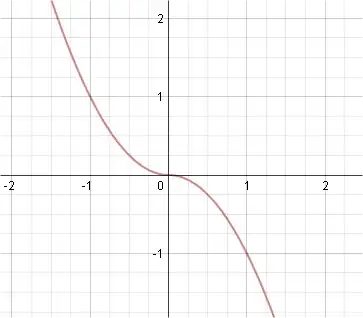My question is about the appearance of a non-analytic function in the formula for the resistive force in air or other medium. Considering the 1-dimensional case as covered by Walter Lewin in his 8.01 lecture, the magnitude of the resistive force is proportional to the square of the speed of the object, which we take to be a sphere. In other words
$$|F|=cv^2$$ with the force being in the opposite direction of the object's motion.
The constant $c$ depends on the sphere's radius, drag coefficient of air and so forth, but for convenience choose values that make $c=1$.
I understand this is an approximation, and in reality there is a $v$ term as well as the $v^2$ term, and maybe other terms as well, but I don't think that invalidates my question.
With that said, here's is a graph of the resistive force $F$ as a function of $v$:

Because the sign of the force is opposite that of velocity, the equation can be conveniently written $$F=-v|v|$$
Although this function looks smooth and has a derivative, $2|x|$, it doesn't have a second derivative. Isn't it unusual for a simple equation of a physical phenomenon in classical mechanics to lack a second derivative? It's unintuitive to me that the force doesn't have a second derivative. Physically, it doesn't feel like anything non-smooth is going on.
My question: Is it normal to encounter functions in classical mechanics with no second derivative, and if not, what's the explanation for finding one here?
Added: For anyone interested in this topic, a related question popped up over at MathOverflow and there are several good answers.